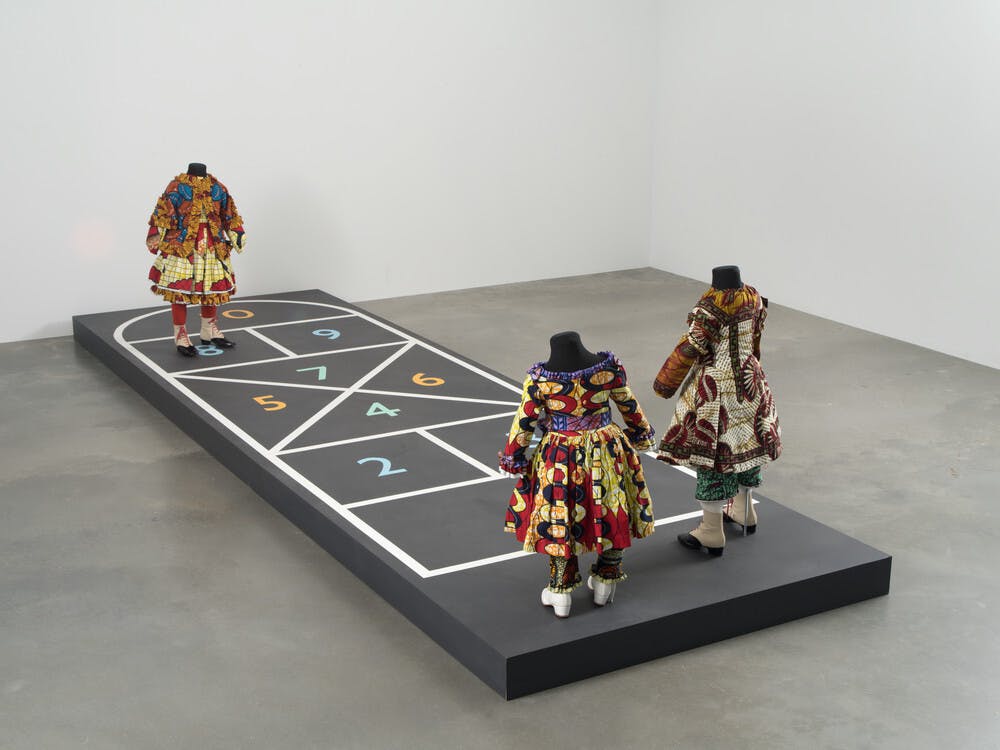Yinka Shonibare
(b. 1962)Yinka Shonibare uses his multimedia practice to probe the overt and concealed intricacies of prejudice.
Biography
Meditating on global trade, migration, and interconnectivity, Yinka Shonibare describes himself as a “post-colonial hybrid,” both impacted by and investigating imbalances of power.
Born in London to Nigerian parents, he moved to Lagos at age three. He spent summers in England and elected to return there to study fine art. Just a few days after starting college, he developed transverse myelitis, which left him partially paralyzed. He gained international recognition for his work following his inclusion in Documenta XI (2002), before receiving a nomination for the Turner Prize in 2004. Across his practice, he questions the construction of nationally or culturally bound identities, and their inevitably blurry boundaries: “I can’t be defined without the British-colonial experience of my birth and background. I don’t exist without it. My biggest preoccupation is with the idea of universal humanism. We all influence each other. Can you imagine Picasso without African art?”[1]
Throughout sculpture, installation, painting, film, and photography, Shonibare deploys canonical Western references to unearth the inherent tensions of nationally structured identities. He investigates the shared and intertwined economic and political histories of globalized Europe and Africa. Muddying the lines between low- and high-class objects and motifs, he works with a wide variety of materials and consistently incorporates Dutch wax fabric, colorfully patterned textiles common to West and Central Africa. These fabrics were originally manufactured in the Netherlands for an Indonesian market, but became so popular in Africa that their original purpose is commonly obscured and hidden—making them a powerful and layered material that embodies many of Shonibare’s primary concerns.
Shonibare studied at Byam Shaw School of Art, London and received his MFA from Goldsmiths, University of London. He received numerous awards, including the Barclay’s Young Artist Award from Serpentine Gallery (1992); African Arts Award from the National Museum of African Art (2016); and Whitechapel Gallery Art Icon Award (2021). In 2013, he was elected a Royal Academician. The Studio Museum has presented his work in the touring exhibition Transforming the Crown: African, Asian and Caribbean Artists in Britain, 1966-1996 (1997; organized by Caribbean Cultural Center African Diaspora Institute); and Yinka Shonibare (2002).
[1] Fiona Maddocks, “In the studio with Yinka Shonibare RA,” Royal Academy, February 29, 2016.
Yinka Shonibare
(b. 1962)Yinka Shonibare uses his multimedia practice to probe the overt and concealed intricacies of prejudice.
Hopscotch, 2000
Biography
Meditating on global trade, migration, and interconnectivity, Yinka Shonibare describes himself as a “post-colonial hybrid,” both impacted by and investigating imbalances of power.
Born in London to Nigerian parents, he moved to Lagos at age three. He spent summers in England and elected to return there to study fine art. Just a few days after starting college, he developed transverse myelitis, which left him partially paralyzed. He gained international recognition for his work following his inclusion in Documenta XI (2002), before receiving a nomination for the Turner Prize in 2004. Across his practice, he questions the construction of nationally or culturally bound identities, and their inevitably blurry boundaries: “I can’t be defined without the British-colonial experience of my birth and background. I don’t exist without it. My biggest preoccupation is with the idea of universal humanism. We all influence each other. Can you imagine Picasso without African art?”[1]
Throughout sculpture, installation, painting, film, and photography, Shonibare deploys canonical Western references to unearth the inherent tensions of nationally structured identities. He investigates the shared and intertwined economic and political histories of globalized Europe and Africa. Muddying the lines between low- and high-class objects and motifs, he works with a wide variety of materials and consistently incorporates Dutch wax fabric, colorfully patterned textiles common to West and Central Africa. These fabrics were originally manufactured in the Netherlands for an Indonesian market, but became so popular in Africa that their original purpose is commonly obscured and hidden—making them a powerful and layered material that embodies many of Shonibare’s primary concerns.
Shonibare studied at Byam Shaw School of Art, London and received his MFA from Goldsmiths, University of London. He received numerous awards, including the Barclay’s Young Artist Award from Serpentine Gallery (1992); African Arts Award from the National Museum of African Art (2016); and Whitechapel Gallery Art Icon Award (2021). In 2013, he was elected a Royal Academician. The Studio Museum has presented his work in the touring exhibition Transforming the Crown: African, Asian and Caribbean Artists in Britain, 1966-1996 (1997; organized by Caribbean Cultural Center African Diaspora Institute); and Yinka Shonibare (2002).
[1] Fiona Maddocks, “In the studio with Yinka Shonibare RA,” Royal Academy, February 29, 2016.
